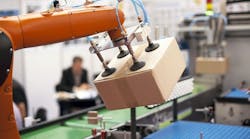Despite the economic slowdown in the industrial sector over the past year, the incidence of actual and planned automation investment is very high in American manufacturing, according to a new report from the MAPI Foundation.
The survey findings show that the high incidence of automation investment spans various company sizes and manufacturing subsectors:
- 83% of respondents indicated they engaged in automation investment in the past five years.
- More than three-quarters (76%) plan to engage in such investment during the next three years.
- 45% indicated their automation investment was part of a broader technology upgrading and 35% said it was a stand-alone investment. The remainder of respondents indicated they engaged in both.
“Automation implementation exhibits characteristics of both capital investment and innovation investment,” observes Cliff Waldman, director of economic studies at the MAPI Foundation. “While deploying machinery into a production line has characteristics of capital equipment investment, it does not appear to be as short-term oriented as capital investment. Automation also does not appear to be an element of business expansion. Rather, it is more like process innovation whose principal goals are cost reduction and product quality improvement.”
“The study also points out that automation investments are more often seen as part of a broader business-wide technology upgrade as opposed to a stand-alone application,” said Joe Kann, vice president of global business development at Rockwell Automation, a sponsor of the report.
Supply Chain Pressures are a Major Influence
Automation use by competitors, customers, and suppliers were three of the top five drivers of automation investment over the past five years, inferring a supply chain and industry influence on this business decision. It also suggests that as supply chains become increasingly global, automation activity by U.S. manufacturing companies will likely spread around the world.
The impact of new technology on product quality was another top driver. The survey shows that the two most common criteria used by U.S. manufacturers for evaluating the performance of new automation technologies are whether they lower total production costs and whether they improve product quality.
Manufacturers that opted not to invest in automation responded overwhelmingly that the perceived return on investment did not justify the total cost of purchase and implementation. Waldman noted that the economic outlook does not appear to be a big motivator in the decision to invest or not to invest in automation.
Size of Company Makes Little Difference in Decision
Stratified by company size, a sizable majority of all cohorts invested or planned to invest in automation. Three-quarters of manufacturers whose average annual global revenues are less than $200 million engaged in automation investment activity in the prior five years. On the other extreme, 97% whose revenues were greater than $10 billion engaged in such investment activity.
But this investment trend is not without potential impediments. According to Waldman, “Human capital challenges, including the difficulty of finding and retaining computer-literate production workers, certainly show themselves to be a cost of automation if nothing else.” Still, given the overwhelming incidence of automation investment, Waldman says, “It seems clear that cost and performance pressures are by and large trumping workforce and other internal impediments in the automation decision function.”
The rapidly changing global manufacturing landscape suggests the need for a broader framework to evaluate the investment in and performance of new automation technologies that goes beyond traditional ROI metrics. In the MAPI Foundation’s final study on productivity, Waldman will examine how companies should measure the ROI of new technology and will discuss the most effective metrics for evaluating the implementation of largely untested technologies.




